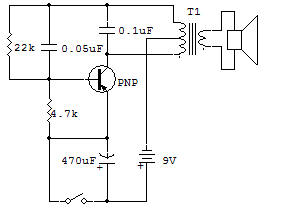

Oscillator with Turn-Off Delay

The purpose of this project is to demonstrate how an OFF delay can be obtained for a circuit. The oscillator used for this demonstration is a common type described elsewhere in this manual see Oscillator Section.
The delay is accomplished with one component, a 470uF Capacitor.
During normal operation of the oscillator the closed Key is in parallel with the Capacitor, so the Capacitor is completely discharged.
At the instant the Key is opened the Capacitor begins to charge. The current necessary to build up a charge must come from the Battery, through the oscillator circuit. The circuit continues to oscillate until the Capacitor is charged up, at which time current stops flowing.
When the Key is closed for the second time it immediately discharges the Capacitor so that delay action is again possible when the Key is opened. This unique characteristic of a Capacitor is called storage-action, and is responsible for many functions the Capacitor can perform.
A discharged Capacitor has an equal number of electrons on the ( + ) and (-) electrodes, but a charge is stored in a Capacitor by drawing electrons off the (+) electrode to make it positive while an equal number of electrons are added to the (-) electrode to make it negative.
The current which flows to establish the charge is called "charging current" or "displacement current". When the Capacitor is charged this same amount of current must flow in the opposite direction to establish the no-charge condition. This current is called "discharge current" or "displacement current".
If you have a VOM, use it to measure the charge on the capacitor with the voltmeter function. The displacement current may be measured with the current function (Amperemeter).
It is this storage action of Capacitors which makes Capacitors in high voltage circuits a source of possible shock or electrocution. Play safe! Discharge Capacitors before touching them if voltages above 50V or so have been applied.
